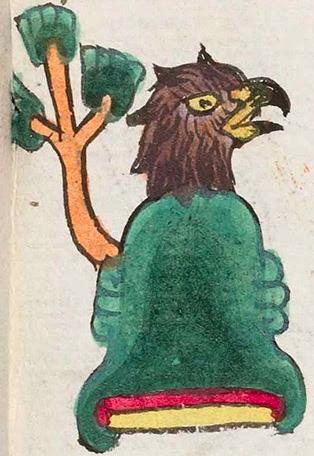Cuauhhuacan (Mdz32r)
This compound glyph for the place name Cuauhhuacan has three principal elements, a tree (cuahuitl) and an eagle's head (cuauhtli). The tree is a standard cuahuitl, with a leader and two side branches, each one of the three parts with two-tone green foliage. But the tree curves out around the eagle's head, coming out of the left side of the mountain. The bark is a terracotta color. The eagle is brown in color, with a yellow eye and beak. Its beak is open. The hill or mountain (tepetl) is silent in this place name, but it could stand for -can (the locative suffix telling where).
Stephanie Wood
The tree is what Gordon Whittaker (Discovering Aztec Hieroglyphs, 2021, 90) calls a phonetic indicator for the word for eagle(s). The vowel length is different, but both words have approximately the same stem, "cuauh." Thus, the reading is loosely reinforced phonetically.
Stephanie Wood
quahuacan. puo
Cuauhhuacan, pueblo
Stephanie Wood
c. 1541, or by 1553 at the latest
Stephanie Wood
eagles, trees, águilas, árboles, hills, mountain, cerros, montañas, nombres de lugares

cuahui(tl), tree, https://nahuatl.wired-humanities.org/content/cuahuitl-1
cuauh(tli), eagle, https://nahuatl.wired-humanities.org/content/cuauhtli
-can (locative suffix), https://nahuatl.wired-humanities.org/content/can-2
Karttunen agrees that this glyph could be read either of the two ways provided by Berdan and Anawalt. She adds that it would depend upon the vowel length, with the cuauh- for eagle having a long a and the cuauh- for tree having a short a.
"Where There Are Eagles" (Whittaker, 2021, 89); "Place Where They Have Trees" or "Place Where They Have Eagles" (Berdan and Anawalt, 1992, vol. 1, 200)
cuauhCUAUH2
Codex Mendoza, folio 32 recto, https://digital.bodleian.ox.ac.uk/objects/2fea788e-2aa2-4f08-b6d9-648c00..., image 74 of 188.
The Bodleian Libraries, University of Oxford, hold the original manuscript, the MS. Arch. Selden. A. 1. This image is published here under the UK Creative Commons, “Attribution-NonCommercial-ShareAlike 3.0 License” (CC-BY-NC-SA 3.0).




